
Wisbech is a market town, inland port and civil parish in the Fenland district in Cambridgeshire, England. In 2011 it had a population of 31,573. The town lies in the far north-east of Cambridgeshire, bordering Norfolk and only 5 miles (8 km) south of Lincolnshire. The tidal River Nene running through the town is spanned by two road bridges. Wisbech is in the Isle of Ely and has been described as "the Capital of The Fens".

Saint Patrick's Cathedral in Dublin, Ireland, founded in 1191 as a Roman Catholic cathedral, is currently the national cathedral of the Church of Ireland. Christ Church Cathedral, also a Church of Ireland cathedral in Dublin, is designated as the local cathedral of the Diocese of Dublin and Glendalough.

Christ Church Cathedral, more formally The Cathedral of the Holy Trinity, is the cathedral of the United Dioceses of Dublin and Glendalough and the cathedral of the ecclesiastical province of the United Provinces of Dublin and Cashel in the (Anglican) Church of Ireland. It is situated in Dublin, Ireland, and is the elder of the capital city's two medieval cathedrals, the other being St Patrick's Cathedral.

The Church of Saint John the Baptist is an active Anglican parish church in the Diocese of Liverpool and lies in the archdeaconry of Liverpool and the deanery of West Derby. It is situated on the corner of West Derby Road and Green Lane, in Tuebrook, Liverpool, England. It was built in the 1860s to a design by GF Botley and is Grade I listed, as a building of exceptional architectural interest. The site also contains the Victorian vicarage and a mortuary house, also by Botley and both Grade II listed. It is also the site of the Brockman Memorial Hall, an early venue of the Beatles.
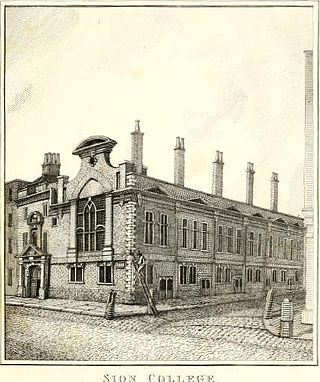
Sion College, in London, is an institution founded by royal charter in 1630 as a college, guild of parochial clergy and almshouse, under the 1623 will of Thomas White, vicar of St Dunstan's in the West.
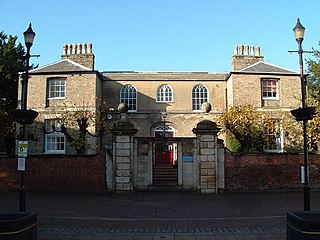
Wisbech Castle was a stone to motte-and-bailey castle built to fortify Wisbech on the orders of William I in 1072, it probably replaced an earlier timber and turf complex. The layout was probably oval in shape and size, on the line still marked by the Circus. The original design and layout is unknown. It was rebuilt in stone in 1087. The castle was reputedly destroyed in a flood in 1236. In the 15th century, repairs were becoming too much for the ageing structure, and a new building was started in 1478 under John Morton, Bishop of Ely. His successor, John Alcock, extended and completed the re-building and died in the Castle in 1500. Subsequent bishops also spent considerable sums on this new palace. The Bishop's Palace was built of brick with dressings of Ketton Stone, but its exact location is unknown.

All Saints' Church, Nottingham, is an Anglican church in Nottingham, England.

St Martin in the Bull Ring is a Church of England parish church in the city of Birmingham, West Midlands, England. It is the original parish church of Birmingham and stands between the Bull Ring Shopping Centre and the markets.
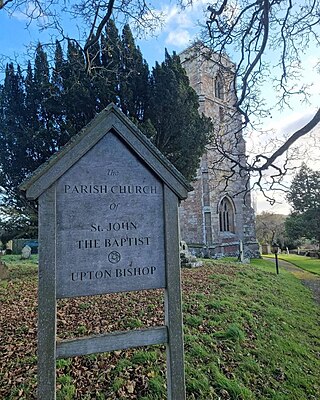
Upton Bishop is a small village in Herefordshire, England. The population of the village at the 2011 census was 602.
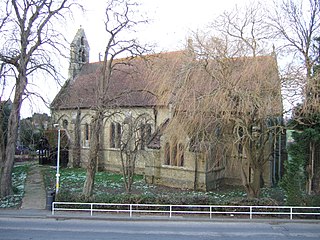
Guyhirn is a village near the town of Wisbech in Cambridgeshire, England. It is on the northern bank, the North Brink, of the River Nene, at the junction of the A141 with the A47. The population is included in the civil parish of Wisbech St Mary. It is notable chiefly for the Chapel of Ease, a rare example of church architecture of the Interregnum (1649–1660), and as a key crossing point of the River Nene.

Leeds Minster, or the Minster and Parish Church of Saint Peter-at-Leeds is the minster church of Leeds, West Yorkshire, England. It stands on the site of the oldest church in the city and is of architectural and liturgical significance. A church is recorded on the site as early as the 7th century, although the present structure is a Gothic Revival one, designed by Robert Dennis Chantrell and completed in 1841. It is dedicated to Saint Peter and was the Parish Church of Leeds before receiving the honorific title of "Minster" in 2012. It has been designated a Grade I listed building by Historic England.

Upwell is a village and civil parish in the English county of Norfolk. Upwell village is on the A1101 road, as is Outwell, its conjoined village at the north. The nearest towns are Wisbech to the north-west and Downham Market to the east.

Wisbech St Mary is a village in the Fenland District of Cambridgeshire, England. It is 2 miles (3 km) west of the town of Wisbech. It lies between two roads, the B1169 and the A47. The population of the civil parish at the 2011 Census was 3,556.

The Church of St Giles is a parish church in Willenhall, Metropolitan Borough of Walsall, West Midlands, England. Although the current church building dates to 1867, a church has been located in Willenhall since c. 1313, where a chaplain is mentioned in one of the Paget deeds. The current parish priest is Revd Sue Boyce.

Walsoken is a settlement and civil parish in Norfolk, England, which is conjoined as a suburb at the northeast of the town of Wisbech, Isle of Ely, Cambridgeshire.
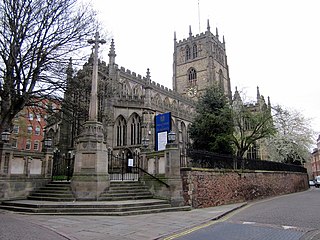
The Church of St Mary the Virgin is the oldest parish church of Nottingham, in Nottinghamshire, England. The church is Grade I listed by the Department for Digital, Culture, Media and Sport as a building of outstanding architectural or historic interest. It is one of only five Grade I listed buildings in the City of Nottingham.
Bishop Ryder Memorial Church, Birmingham, was a parish church in the Church of England in Birmingham from 1838 to 1960.

St Peter and St Paul's Church, Lavenham is a Grade I listed parish church in the Church of England in Lavenham, Suffolk. It is a notable wool church and regarded as one of the finest examples of Late Perpendicular Gothic architecture in England.
St. Barnabas' Church was a Church of Ireland church on Upper Sherrif Street, East Wall, in Dublin's docklands. It was sometimes called the Mariners Church.

St Mary's Church is the parish church of Holme-next-the-Sea in the English county of Norfolk. It is dedicated to the Virgin Mary. The church is partly early 15th-century Perpendicular, and partly later reconstruction. It is Grade I listed.




















